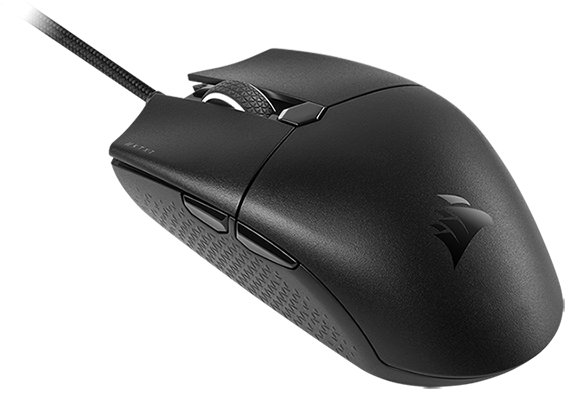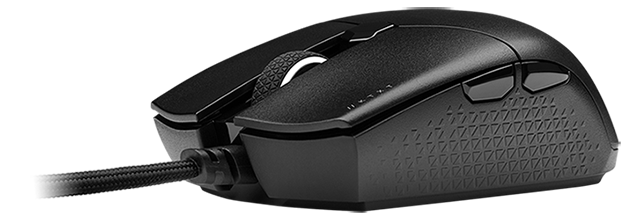Introduction
It is easy to get carried away when speccing a gaming PC, and truth be told, if you're serious about your competitive credentials, there's something to be said for paring it down. Higher resolutions, fancy quality settings and complex peripherals can inadvertently take away some of the competitive edge, and there's a reason why many eSports professionals choose to keep things simple.
If you're that way inclined, there's a good chance you'll feel right at home on Corsair's latest gaming mouse, the Katar Pro XT.
A wired alternative to the existing Katar Pro Wireless, the XT model arrives at retail alongside an affordable £35 price tag and many of the essential features craved by FPS and MOBA gamers. The highlight is a weight of just 73g, which bodes well for fast-paced gameplay and makes the Pro XT almost 25 per cent lighter than its Wireless sibling.
Dimensions of 115.8mm x 64.2mm x 37.8mm feel suitably nimble in the hand, suiting either a claw or fingertip grip style, and the symmetric black form factor is largely free of unnecessary frills. Indeed, there's only one zone of RGB lighting - the clickable scroll wheel, not the Sails logo, surprisingly - and a total of six buttons can be deemed relatively modest by today's standards.
Performance is what matters to the target audience and to that end there's plenty to like. Corsair's custom PixArt PMW3391 optical sensor offers precise customisation between 100 and 18,000DPI in single-digit increments, spring-loaded 'QuickStrike' buttons promise zero gap between the buttons and their underlying 50m Omron switches, and a 6ft paracord USB 2.0 Type-A cable provides a standard 1,000Hz report rate. Corsair describes the cable as 'drag-reducing,' but you will inevitably notice some resistance; going wireless is the only way to eliminate drag entirely, albeit at the expense of battery weight.
Solid ingredients, yet as with all peripherals, the size, shape and feel of the product will suit some users more than others. Personally, I prefer a little more heft to my mouse - the 116mm x 64mm x 38mm profile is a little on the small side for my admittedly large hands - and though I can appreciate Katar Pro XT's agility when gaming, I find it overly lightweight and hollow-feeling during everyday use. The texture of the surface, however, offers just enough grip without feeling clingy, and the two side buttons are perfectly positioned. There's space between them for differentiation, and either is easy to click with little thumb movement; you may even experience a few accidental presses while you adapt to how sensitive they are.
Corsair's subtly-notched wheel offers smooth scrolling without too much resistance, and the DPI toggle button behind it is again easily reached. Three preset DPI settings are available out the box - 800, 1,500 and 3,000 - and it's worth noting that the one-and-only onboard profile can store lighting and DPI settings but not macros or key assignments to take with you.
MM700
As luck would have it, our Katar Pro XT review sample arrived alongside an MM700 RGB Extended Mouse Pad that is broad enough to warrant a specific mention. Measuring 930mm x 400mm, the desk-covering pad uses a 4mm-thick, anti-slip rubber construction topped with black woven textile. The large expanse of black does have a habit of showing dust and grime, but what really catches the eye is the RGB lighting.
Split into three zones - left/top, right/bottom, hub - the illumination can be deemed a neat addition to the desk for creators wanting to be seen, and given the overall size, MM700's surrounding RGB colours and effects are reasonably smooth. Those choosing not to use Corsair's iCue software utility can toggle between effects using a button on the back of the integrated USB hub, where you'll also find the Type-C connector from which the pad draws power via the bundled 6ft Type-C to Type-A cable.
The hub is a neat addition in that it offers a further two USB 2.0 Type-A ports - handy for connecting, say, a headset or wireless receiver - though as a right-handed user I'd prefer it on the pad's left side, well away from my mouse. While I'm nitpicking, Corsair's transparent stitching does a good job of holding the light diffuser in place without dampening the effect, but it is also clearly visible against the black textile, feels rough against the skin and detracts from the overall aesthetic. Last but not least, the MM700 is expected to fetch £60 at retail, meaning in this case the mouse pad is pricier than the mouse itself.













